Although it’s not one of the most glamorous parts of RV ownership, your sewer hose is one of the most important.
Without it, things would get pretty messy, so you want to do whatever you can to keep it in good condition, including how you store it.
What’s the right method for RV sewer hose storage? The best place to store a sewer hose is in a dedicated storage compartment within the RV that fits the size of the hose.
Most modern hoses can shrink down to a compact size when not in use so storing them away correctly is easy enough to do.
To keep your sewer hose in top shape and prevent kinks and cracks, correct storage is key.
We’re going to show you how to do it right as well as some DIY hacks to use when you’re in a bind, so you’ll always have a sewer hose in good condition to rely on.
Contents
The Importance of Sewer Hose Storage
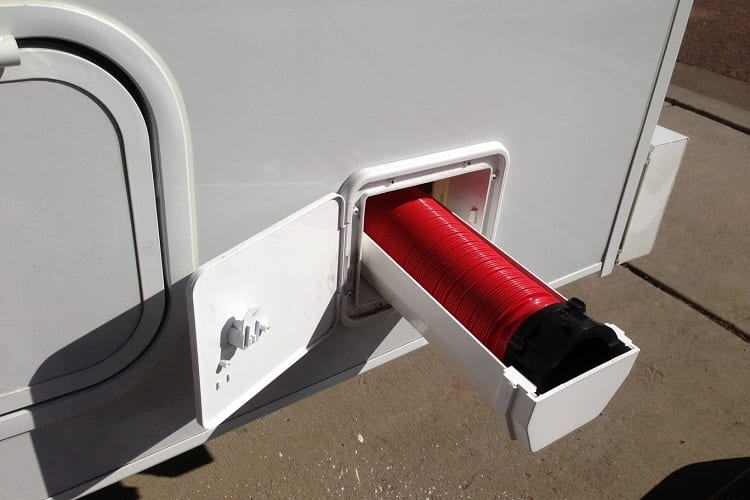
A standard sewer hose has a length of between 15 to 20 feet and when it’s laid out in full, it can be pretty big.
Rather than finding somewhere to place this in your RV, these sewer hoses are made to shrink down in size to a compact shape so they can be stored away more easily.
The problem with this type of design and the compressed state it keeps, sometimes the hose will develop cracks or kinks during storage.
You might not realize until it’s time to use it that there’s anything wrong and you don’t want to discover this while you’re at the dump station halfway through the job.
Therefore, coming up with a protective storage solution that prevents any damage from being done to the sewer hose is essential.
The first step to ensuring a sewer hose is stored correctly is having the right hose to begin with.
This isn’t a piece of RV gear you want to cheap out on, as anyone who’s worked with a broken hose will attest to.
You’ll want to choose a durable yet flexible sewer hose with enough length to suit your RV setup one that can be stored away without becoming kinked or creased.
The Right Way to Store a Sewer Hose
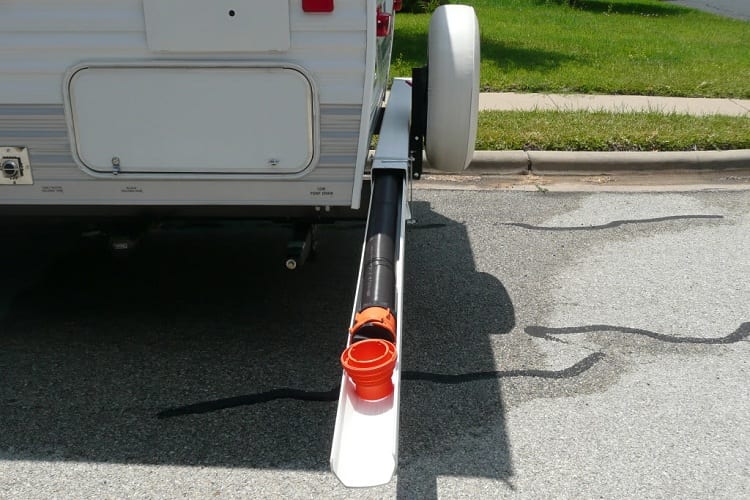
With so many methods out there for storing a sewer hose, the easiest and most effective seems to be a ready-made storage container.
These are designed specifically for keeping sewer hoses tucked away in an RV and they do the best job of preventing kinks, cracks, and other forms of damage. Follow these steps to store your sewer hose away correctly every time:
- Close the sewer dump valve: The very first thing to do is make sure that the sewer dump valve is closed before you disconnect the sewer hose. This will prevent any waste from escaping once it comes off.
- Clean outside: Find a water hose to wash the outside of the sewer hose and all of the parts and connections. Do not use the drinking water hose of your RV. Once washed clean, disconnect the end that’s attached to the RV.
- Clean inside: Use the same hose to now wash out the inside of the sewer hose from the RV end so that it’s washing everything down into the dump station. Once it’s washed out thoroughly, disconnect the end attached to the dump station.
- Dry the hose: Get rid of any excess water left in the hose so it’s not kept inside during storage. Give the hose time to dry in the sun if you’re able to.
- Disinfect everything: Wipe down the ends of the hose, the outside of it, and where the hose connects to the RV with a disinfectant and allow it to dry.
- Cover the ends: Most modern sewer hose containers will also include caps for the ends of the hose, and it’s important to use these. If you don’t have any caps, you can cover the ends of it with a plastic bag so that anything left behind in there doesn’t make its way out.
- Store it in the container: Push the sewer hose down so that it’s compacted as far as it can go. Open the lid of the container, put it inside, and close it down firmly until you need it again. This process might differ between storage container shapes and sizes, so follow the directions of yours to get it right.
DIY Sewer Hose Storage Ideas
If you’re not interested in getting one of the sewer hose storage options that are ready-made or yours has been misplaced, there are some DIY approaches you can try.
These are just a few ideas for storing the hose in your RV that will still save space and work as a temporary fix.
PVC Pipe
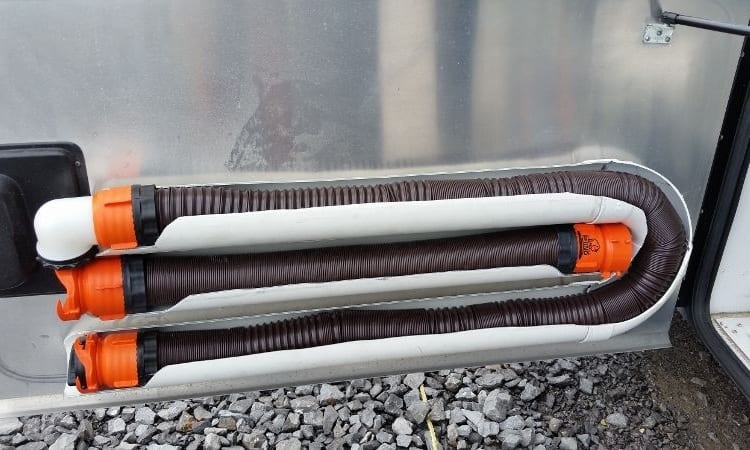
If you’d rather keep your sewer hose straight and not curled, you can store it away in a hollow PVC pipe instead.
This is better for a long-term solution but takes a little more work, and you’ll need to find somewhere to store your new hose holder on the inside or outside of the RV.
Cut down the pipe to a size that will comfortably fit the sewer hose, and make sure you have caps for either end. Drill a few ventilation holes into the pipe so it gets air and reduces bacteria growth.
Once the sewer hose has been cleaned and dried, push it straight through the pipe and cover each end with the caps.
Garbage Bag
A garbage bag is a quick fix for a storage solution when you have nothing else but it’s only intended to last until you reach your next destination.
Once the hose has been disconnected and cleaned, you can dry it out and compress it down.
Curl the hose down and place it inside the bag. You might want to use zip ties or something to keep it compacted as it won’t have a container to do it for you.
Make sure you store it somewhere so it’s labeled and easily differentiated from a regular garbage bag.
Bucket
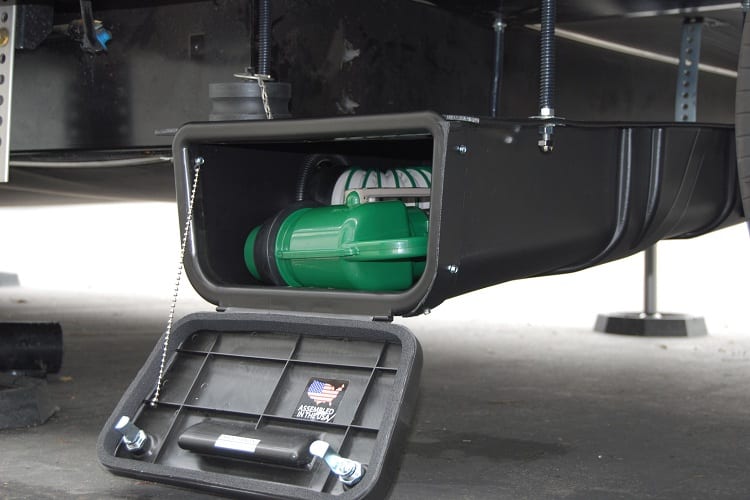
Most RVs have at least one spare bucket laying around, and if you need to store a sewer hose in a pinch it can be a great way to do it.
Just make sure the bucket has a lid and that it’s large enough to fit the hose once it’s fully compressed, which is usually a five-gallon bucket.
Follow the earlier steps of rinsing out, cleaning, and disinfecting the hose, and then take special care to dry it thoroughly. This is even more important when using this method because of the potential for mess.
Once dry, cover the ends, curl the hose down into the bucket, and place the lid on.
Sewerage Storage Done Right
There’s nothing glamorous about finding a spot for the sewer hose in your RV but there is a lot of purpose behind it.
This is one part you want to keep in good condition so you can always rely on it, and with a bit of attention given to creating a smart storage solution, you’ll keep it working for you for years to come.
Related Questions
A sewer hose is an integral part of any RV setup that uses a black water tank and it’s not something you want to risk going wrong.
If you’re still on the hunt for the best sewer hose and want to know more about how it all works, check out our answers to some commonly asked questions to get you started.
Do I Need a Sewer Hose Support?
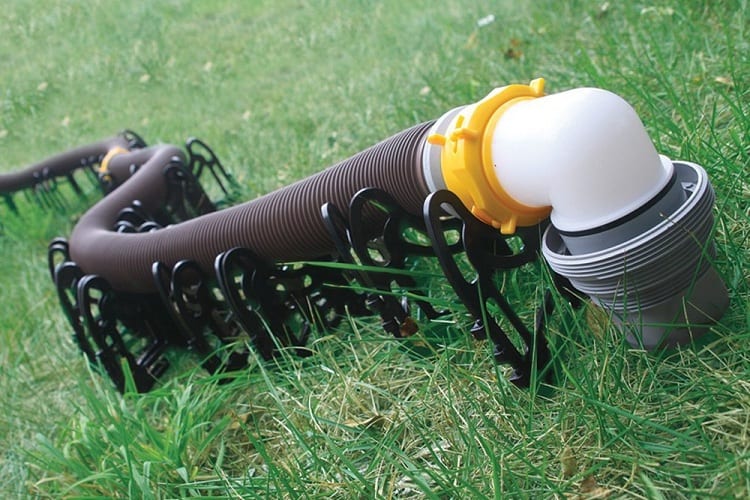
Sewer hose support systems are designed to keep the hose off the ground, out of the way of damage, and to allow gravity to assist the flow of waste through them.
While they’re not needed, they can make the job easier and will keep them protected from whatever’s on the ground.
Do New RVs Come With Sewer Hoses?
Modern RVs are usually sold with a sewer hose and a water hose included, as well as a storage compartment to keep them.
However, if you have specific needs for a hose or would prefer a certain brand, you can easily replace this or keep a backup somewhere in the RV for your peace of mind.
Are RV Sewer Hoses Universal?
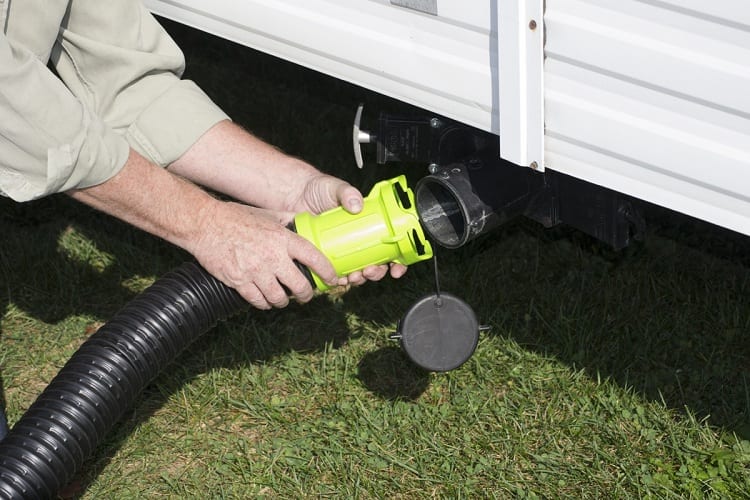
Not all RV sewer hoses are made the same and you’ll need to measure the waste valve on your RV to see what works.
Generally, a sewer hose uses a 3-inch diameter tubing but this can vary depending on a few factors.
The connection point of the waste valve should also be considered as each product requires something different.
Resources:


